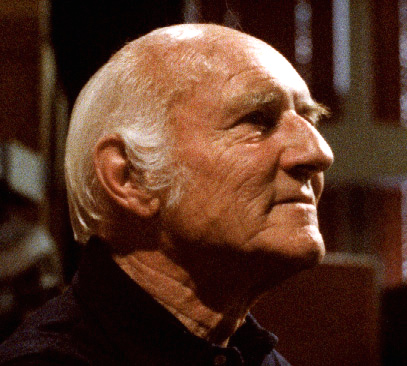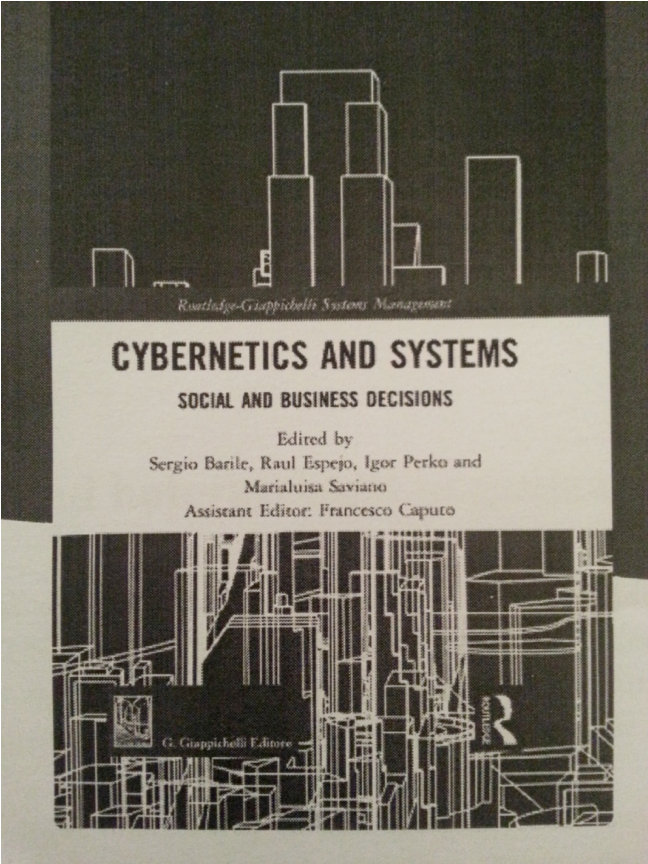From Systems Theory to Systemics
Some Remarks by Heinz von Foerster[1]
Umberta Telfener[2]
As an Introduction
I met Heinz for the first time at a conference held by ISCRA systemic Institute in Modena, back in 1985. He was with the psychotherapist and theoretician Carlos Sluzky and they were talking about Popper’s falsification theory. The translator was very imprecise and the listeners got nervous. I decided to translate taking the place of the official professional. That was the beginning of a long friendship and collaboration. I speak English with a little German accent, we kind of recognized each other and we got along together very smoothly ever since: same energy level, same Austrian background, sympathy, friendship …
A teacher/student relationship was born. For the first time I understood the difference between first and second cybernetics (the former dealing with static processes tending to status quo, the second with evolutive ones), and the difference between first order and second order cybernetics (different from first and second cybernetics), the first considering the observer as an outsider and dealing with observed systems; the second dealing with observing systems which include the viewer in the process and enhance reflexivity[i].
Since then, we would meet any time he would come to Europe and I went and visited him and his beloved wife May in Pescadero, California, more than once, meeting his two sons and spending time with the family in their home in the American hills; a house he had built by himself and loved and cared for very much (cutting stinging ivy and watching dears and other wild animals). I remember long talks in the Jacuzzi on the terrace and Heinz being stopped by the police more than once because of his car speed (each time it ended with long coffee laughing conversations with the policeman).
I edited with Mauro Ceruti, an Italian epistemologist, Heinz’ book Observing systems and interviewed him for many journals. He would revise my articles and we had conversations in conferences together (among others the Gordon Research Conference on the cybernetics of cognition in 1986).
I clearly was the student; he was the thinker with big experience and many anecdotes to share (I cannot utilize the term “expert” since he did not ever behave as an expert). A complementary positioning that didn’t restrain me from teasing him for his constant optimism and his steady thirst to explore: I never heard him complain, every moment he would redefine what was happening in order to open up to possibilities.
He became the person to whom I would turn to have theory explained. Probably this was the reason why it came to our mind to build the project of the book Systemics, voices and paths within complexity, which was edited in Italy in 2003 (Bollati Boringhieri, Torino), project that he closely supervised.
Heinz’ wanted a dictionary which would not sedate the reader. He wanted a book which gave very different definitions on each item, not creating an harmonious point of view but rather some anxiety and curiosity on the reader’ side. He desired to make the booklover think, enhancing the number of questions instead of giving answers. That’s why we constructed a book in which every concept gave life to different definitions, which were not coherent with one another, built as a hypertext in a cybernetic manner. We decided together the words to unfold as ribbons. Once he was in Roma we had the interview which went on for three days together, in my home, with my co-author Luca Casadio and a common friend Paolo Perticari, a pedagogic practitioner and a system thinker, the most similar man to Heinz I ever met in terms of personality and way of acting.
We had brief sessions and listened to many anecdotes, stories about the field and about the Computer Biological Laboratory in Urbana[ii]. We mostly spent time at the dinner and lunch table. The feeling was that through the questions asked Heinz would make his thinking even clearer and would specify some connections. He used to say that as systemic psychotherapists we would practically act what he was theoretically thinking and teaching and he loved coming behind the one-way mirror, looking for non-verbal communication and speculating about what was happening.
He had got involved in psychotherapy for the first time in Calgary – at the institute of Karl Tomm – where he had watched a session by Boscolo and Cecchin and had commented with enthusiasm on this way of working, the Milan style: “I think it is fascinating that in your work the only instrument you utilize is the word. I think it is essential to speculate what the magic of words makes happen in therapy. Your clients are required to become like poets through the process of asking questions. The question, and this is fascinating, has no meaning when it is asked, it gathers a significance when it is answered: who answers must invent and therefore activates a process of self-creation.”
What do I treasure about Heinz? His wit, his energy, his lightness, the capacity to see the positive and funny part of any happening, his desire to communicate and be loved by any human creature he would encounter. His energy was outstanding and tiring for his adventure companions. I remember going around Milano at three in the morning looking for something for him to eat (he would eat very little but very frequently); or a walk in New York where we passed under the New York Times building and his comment about the writing on the main entrance:“Tell it as it is”. “How naïve on their part” – he commented – “There should be written ‘It is as you tell it’.”
I think that the coherence between his theorization and the practice of the Milan group has been for me an added value, and has helped me evolve into who I have been becoming. I am full of anecdotes about Heinz and will keep them for my entire life as treasures. I continue reading his thoughts and every time understand something more about this challenging practice.
(Extract of the Introduction of SYSTEMICS:
There should be two complementary ways of seeing and thinking. One is the way peculiar to science (currently thought of too often with a capital S), which comes from sci (divide) and also puts forward a definitive methodology. Then there is the complementary way of thinking and observing of systemics, which comes from sun (put together), in such a way that the different divided parts together form a whole. If you choose to divide, it’s science. If you are instead concerned with complementarity, you can enter a systemic paradigm whereby one logic is capable of representing another and complementarity and overlapping are reflected in each other. In this way, each of the two modalities represents and defines the other. General systems theory already sets itself the goal of not dividing things and observations but connecting them to one another and considering them together.
The strength of the work done in physics lies instead precisely in division, whereby if I don’t understand the whole, I can divide the parts and understand some of them even though the whole escapes me. To talk about science, art or even the weather, you have to make a choice. You can use the scientific model with its way of organizing the data: carry out research, test a theory, try to falsify it, devise models, discard hypothesis. You can also opt for the systemic approach based on dialogue, on a typical form of focus on human relations that reinstates science in its original domain of human dialogue.
The problem of physics and the so-called hard sciences (physics, chemistry and biology) is that they deal with soft problems, i.e. problems that can always be divided to the point where you are left with units that are easy to handle. The so-called soft sciences (sociology, psychology, anthropology) instead deal with ‘hard’ problems, i.e. complex problems that cannot be reduced to simpler forms.
Systemics is concerned with the rules of composition and deals above all with interaction between parts. The term “systemic” is frequently misused if understood as an adjective, as in a systemic approach, a systemic therapy, a systemic way of thinking. What actually happens is that we don’t think sufficiently about what we are doing, how we operate as systemicists. My proposal is to invent a new term, namely the noun systemics. Systemics thus becomes a way of observing and addressing the world.
There is a splendid term for science in German, namely Wissenschaft, which means knowledge production, something that produces knowledge. Knowledge can be produced in very different ways. It can be produced by separating things or putting them together: separating things and looking for differences or putting them together and looking for similarities and points of contact. The term system derives precisely from the Greek word for one and sun (put together). What it means etymologically is putting things in one, making them one.
I propose to consider systemics as a position, a way of observing, a cognitive attitude. Drawing a distinction is scientific; seeing complementarity is systemic. In this perspective, concepts overlap through the reciprocal definition of the self and the other.
It is not necessary to choose one approach or the other. We must use both at the same time in order to obtain greater depth of field.
You ask me to go on talking about what systemics is? I will reply by explaining my interest in the form of the question and the form of the answer. I think that the idea of “form” is not fully understood. If someone asks me what consciousness is, for example, I can say, ‘Let’s look it up in a good dictionary.’ If she isn’t happy with the form of the dictionary, I can suggest looking it up in an etymological dictionary. She could then reply that she isn’t interested in where the term comes from but in something else.
When you ask me what systemics is and invite me to go on talking about it, I reply that I am interested in the form of your question and also in your expectations as regards the answer. My question comes to regard the forms in which a dialogue works and develops. Addressing the form of the questions and answers leads to thinking of a dialogue, which I see as a dance; a dialogue understood as an interactive operation in which causality disappears. If we are talking about a scientific definition of consciousness, for example, we can look it up in the books. When we look for a definition of systemics, significance attaches not so much to the answer as to the dance prompted by the question, which becomes a dialogue. It becomes interaction and builds up complementarity between two or more people who come into contact. Even though we have called them complementary, these are therefore two very different domains. Systemics is developed by people who want dialogue, who want to think together, to dance. Examining the form of the question means highlighting or in any case negotiating a common domain. Analyzing the context of the question means not giving answers that bring the conservation to an end but asking which shared domain the question was framed in.
Dialogue makes it possible to meet and to move beyond separate identities and the fragmentary nature of language. Being together becomes the important thing. This is an interactive operation in which two people become one, in which I have to put myself in the other person’s shoes in order to talk and s/he is forced to put him/herself in mine. We each see ourselves through the eyes of the other. In this way we come to form a unity. Separate identity disappears. Identity loses its explicative and explanatory power, and the very idea of explanation takes on a different dimension. I would also say that the logic of the two systems, the scientific and the systemic, are completely different. As regards language, we have two completely different spheres. In one there is appearance and appearance defines identity. It separates. It is similar to science. Appearance is always syntax. A person wishing to construct a meaningful sentence has to organize it with a subject and a predicate, to put in the commas, make pauses at certain points, decide how to do it.
A part of language has to do with understanding sentences but the other aspect, the semantic aspect, is a miracle. Syntax presents a linear and logical causality. Semantics is organized like a network. It establishes a net-like relationship stretching in many different directions.
Personally, I regard men as tending more towards syntax and women towards semantics. There are two different forms of logic, one syntactic and one semantic.
The arguments of McCulloch and Bateson are typical examples of semantic logic. In his renowned article on the heterarchy of values determined by the topology of the nervous system, McCulloch demonstrated that there are systems as rigid as military or religious structures that think in terms of a universal “best”. In actual fact, the salient aspect that McCulloch demonstrates is that the nervous system cannot compute a definitive value but works through a heterarchy, i.e. through a constant selection of values based on circular logic. I regard this as one of the greatest contributions to science of the 20th century. McCulloch said: Suppose a person has the choice of an apple and a banana, and chooses the banana. Then he has the choice of a banana and a cherry, and chooses the cherry. If he is now asked to choose between an apple and a cherry, a logician will assume that he must go for the cherry again, whereas the apple is also a possibility from the semantic standpoint. The logician will say: “Look how stupid people are. They cannot think logically.” Bateson and McCulloch instead said: “Look how stupid logicians are. They can’t even understand how people think.”
How can we develop a logic capable of accommodating this unpredictability? The new definitions and the new problems in science are not invented but emerge in the dialogue between two or more people who do not know how to solve a problem and try to address it in a joint dance. Scientists do not therefore sit down at their desks and invent new concepts; new concepts emerge from their dance, from their shared doubts and relationship. Let me give another quick example to clarify the difference between the two ways of approaching knowledge. In his day, von Bertallanffy put forward a general theory of systems that was in line with the times. The word “theory” would not be included in my “systemic dictionary”, however. Theory is a concept that belongs to the domain of science, not of systemics. In order to be valid, a theory must be falsifiable and Popper’s concept of falsifiability, though very valid and indeed indispensable, is not consistent with systemics because it presupposes a linear logic. Systemic logic is related to semantic logic, whereas scientific logic is syntactic and its rules are given from outside. The simple logic of syntax is crucial in order to examine, understand, analyze and dissect the rules of the sounds made in order to speak; the role of semantics is to make sense of the sounds. The logic of semantics is required to connect innumerable data.
[1] Extract of the Introduction of SISTEMICA: Voci e Percorsi nella Complessità (SYSTEMICS: Voices and Paths within Complexity), Ed. Umberta Telfener & Casadio Luca, Bollati Boringhieri, Torino, 2003.
[2] Clinical psychologist and mental health worker, trainer and supervisor of the Centro Milanese di terapia della Famiglia. utelfener@gmail.com
[i] Theoriticians started differentiating between first and second cybernetics in dealing with the typical cybernetic circular processes. Margaret Mead and Heinz von Foerster, during the Macy Conferences, invented the difference between first order and second order cybernetics, the first dealing with observed systems the second one with observing systems, in which the observer is within.
[ii] At the BCL, University of Chicago, directed by Heinz von Foerster, many systemic thinkers passed by: Varela, Maturana, Uribe, McCulloch, Wiener, Gordon Pask, Stafford Beer, Spencer Brown; but also an Israeli dancer and other interested in systemic complex processes.




